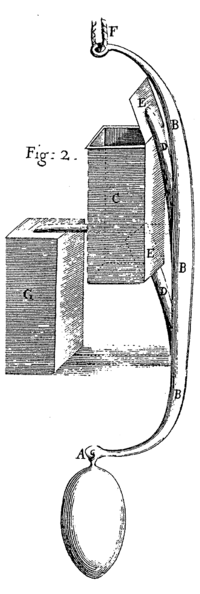(149)
out a method to calculate, what depth is to be concluded from any other time of the like Globes stay under water.
In the same Tryals, made with this Instrument in the said River of Thames, it has been found, that there is no difference in time, between the submersions of the Ball at the greatest depth, when it rose two Wherries length from the place where it was let fall (being carried by the Current of the Tide) and
when it rose within a yard or so of the same place where it was let down.

Figure 2
The other Instrument, for Fetching up water from the depth of the sea, is (as appears by Figure 2.) a square woodden Bucket C, whose bottoms EE, are so contrived, that as the weight A, sinks the Iron B, (to which the Bucket C, is fastned by two handles DD, on the ends of which are the moveable bottoms or Valves EE,) and thereby draws down the Bucket; the resistance of the water keeps up the Bucket in the posture C; whereby the water hath, all the while it is descending, a clear passage through; whereas, as soon as the Bucket is pulled upwards by the Line F, the resistance of the water to that motion beats the Bucket downward, and keeps it in the posture G, whereby the Included water is preserved from getting out, and the Ambient water kept from getting in.
By the advantage of which Vessel; it may be known, whether sea water be Salter at and towards the bottom, then at or near the top: Likewise, whether in some places of the sea, any sweet water is to be found at the bottom; the Affirmative whereof is to be met with in the East Indian Voyages of the industrious John Hugh Van Linschoten, who page 16 of that Book, as 'tis Englished, records, that in the Persian Gulph, about the Island Barem, or Baharem, they fetch up with certain Vessels (which he describes not) water out of the sea, from under the salt-water, four or five fathom deep, as sweet, as any Fountain water.
